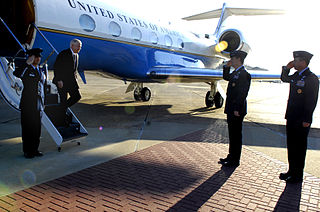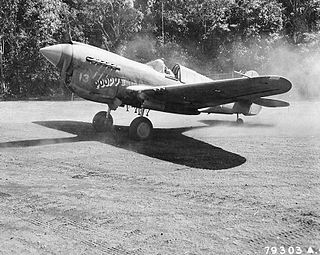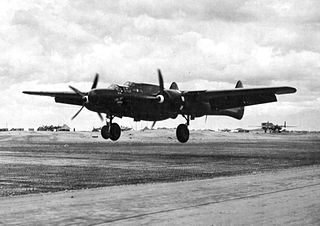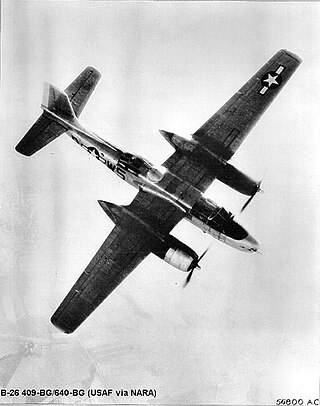
The 42nd Air Base Wing is a United States Air Force unit assigned to Air University of Air Education and Training Command. It is stationed at Maxwell-Gunter Air Force Base, Alabama and is the host unit for Maxwell-Gunter. The wing's primary mission is to support all activities of Air University, the 908th Airlift Wing and other tenant units stationed at Maxwell-Gunter.

The 497th Air Expeditionary Group is a provisional United States Air Force unit. It is assigned to Pacific Air Forces to activate or inactivate as needed.

Girua Airport is an airport serving Popondetta, a city in the Oro province in Papua New Guinea.

The 312th Aeronautical Systems Group is an inactive United States Air Force unit. It was last active in June 2010 at Wright-Patterson Air Force Base, Ohio, where it was a component of Air Force Materiel Command.

The 108th Operations Group is a unit of the 108th Wing of the New Jersey Air National Guard, one of the many units stationed at the McGuire AFB entity of Joint Base McGuire-Dix-Lakehurst, New Jersey. If activated to federal service with the U.S. Air Force, the group is gained by Air Mobility Command.

The 418th Test and Evaluation Squadron is an active United States Air Force unit assigned to the 53rd Test and Evaluation Group, and stationed at Davis-Monthan Air Force Base, Arizona, where it was activated on 1 October 2021.

The 309th Air Division is an inactive United States Air Force organization. Its last assignment was with Continental Air Command, assigned to Twelfth Air Force at Hensley Field, Texas. It was inactivated on 27 June 1949.
Saidor Airport is an airport in Madang Province, Papua New Guinea.. It is a general aviation airport located at the coast near Saidor, near Saul Point with Dekys Bay to the east and the Bismarck Sea to the north.

Oro Bay Airfield is a former World War II airfield in Oro Province, Papua New Guinea. The airfield was abandoned after the war and today is almost totally returned to its natural state.

The 499th Bombardment Squadron is an inactive United States Air Force unit. It was last assigned to the 345th Bombardment Wing at Langley Air Force Base, Virginia, where it was inactivated on 25 June 1959.

The 672d Technical Training Squadron is an inactive United States Air Force unit. Its last assignment was with the 705th Strategic Missile Wing at RAF Lakenheath, England, where it was inactivated on 1 October 1959.

The 673d Bombardment Squadron is an inactive United States Army Air Forces unit. Its last assignment was with the 417th Bombardment Group at Itami Airfield, Japan, where it was inactivated on 5 November 1945.

The 674th Bombardment Squadron is a former United States Army Air Forces unit. Its last assignment was with the 417th Bombardment Group at Itami Airfield, Japan, where it was inactivated on 5 November 1945.

The 675th Bombardment Squadron is a former United States Army Air Forces unit. Its last assignment was with the 417th Bombardment Group at Itami Airfield, Japan, where it was inactivated on 5 November 1945.

The 820th Bombardment Squadron is a former Army Air Forces unit, inactivated on 4 January 1946. The squadron was first activated during World War II as the 521st Bombardment Squadron. The squadron was soon engaged in the antisubmarine campaign off the Atlantic coast of the United States as the 16th Antisubmarine Squadron.

The 90th Expeditionary Air Refueling Squadron is a provisional United States Air Force unit. Until March 2013, it was assigned to the 385th Air Expeditionary Group at Incirlik Air Base, Turkey. It then departed for an undisclosed location in Southwest Asia.

The 340th Expeditionary Air Refueling Squadron is a provisional United States Air Force unit. It is assigned to the 379th Expeditionary Operations Group at Al Udeid Air Base, Qatar. It has supported combat operations in Afghanistan, Iraq, and Syria from this location.

The 640th Bombardment Squadron is an inactive United States Army Air Forces unit. After training with Douglas A-20 Havocs in the United States the squadron deployed to the European Theater of World War II, where it engaged in combat until the Surrender of Germany. It was last assigned to the 409th Bombardment Group at Westover Field, Massachusetts, where it was inactivated on 7 November 1945.

The 642d Bombardment Squadron is an inactive United States Army Air Forces unit. After training with Douglas A-20 Havocs in the United States the squadron deployed to the European Theater of World War II, where it engaged in combat until the Surrender of Germany. It was last assigned to the 409th Bombardment Group at Westover Field, Massachusetts, where it was inactivated on 7 November 1945.

The 643d Bombardment Squadron is an inactive United States Army Air Forces unit. After training with Douglas A-20 Havocs in the United States the squadron deployed to the European Theater of World War II, where it engaged in combat until the Surrender of Germany. It was last assigned to the 409th Bombardment Group at Westover Field, Massachusetts, where it was inactivated on 7 November 1945.























